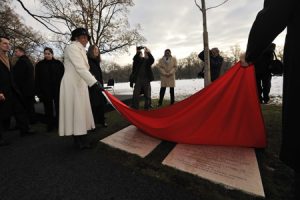Budapest, Wednesday, November 26, 2008

Photographer: Sgt Serge Gouin
I am deeply moved to be standing before you, not far from the monument commemorating the events of 1956—when so many hopes and lives were brutally wiped out—so that I may unveil this plaque honouring the thousands of Hungarians who found refuge in Canada.
The tragedy of the Hungarian people, the plight of the refugees who arrived in our country by the thousands, profoundly touched Canadians.
And it was with open arms, in a spirit of solidarity, out of respect for their suffering and admiration for their courage that they welcomed those women and men whose only fault was the desire to live free.
The Canadian government at the time made special provisions to transport them to Canada. Two weekly flights brought Hungarian refugees from Vienna, not to mention the ships that were chartered for that purpose.
A monumental national effort then ensured that those new arrivals felt at home in our country. There were already many Hungarian families living in Canada, who had arrived in a first wave of immigration in the 19th century.
And they opened their hearts to them, welcoming them with the same warmth as though they were family and friends.
In his book on the Hungarian-Canadian experience, Professor Dreisziger wrote that a “fund-raising drive was launched. Hungarian-Canadians and Canadians of all backgrounds collaborated, more than in any earlier schemes.”
In the aftermath of the insurrection, which had been crushed by the Soviet army, the Hungarian women and men who arrived in Canada were able to rebuild their lives free from repression and regain their freedom by setting down new roots in North American soil.
Through their tireless efforts, those women and men helped to make Canada one of the most prosperous countries in the world.
They enriched us with their desire to contribute to the greater good, their ingenuity, their business acumen and their cultural heritage.
I still get nostalgic when I think of the Sam Steinberg supermarkets, of Sarosi shoes and the market stalls of Hungarian merchants who had set up shop in Montréal, where I lived for most of my life.
The story of the Hungarian refugees is one of struggle, of putting down roots and of perseverance.
It is a story that I know only too well.
Because their story is my story and the story of so many of my fellow citizens who fled from regimes of terror and oppression.
For them, as for me, Canada is a country where anything is possible, and this plaque is a moving testament to that conviction.
May this plaque also be, for you and for your fellow Hungarians, an ode to newfound freedom, a song of friendship, a symbol of hope and a promise for the future.
